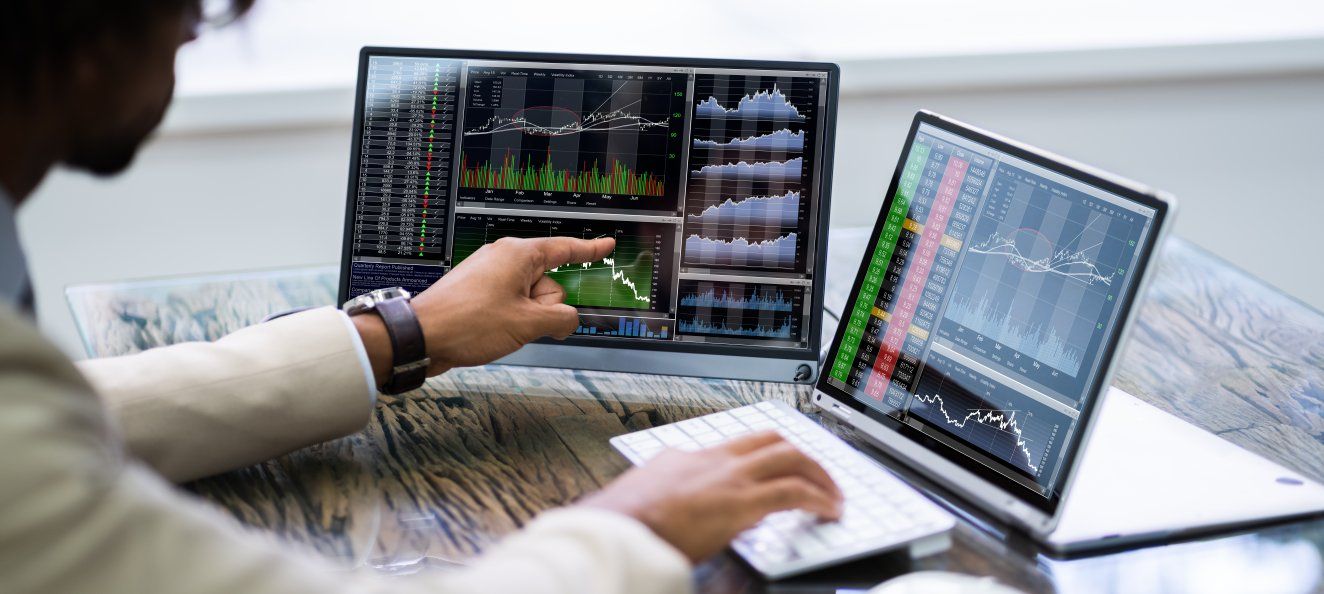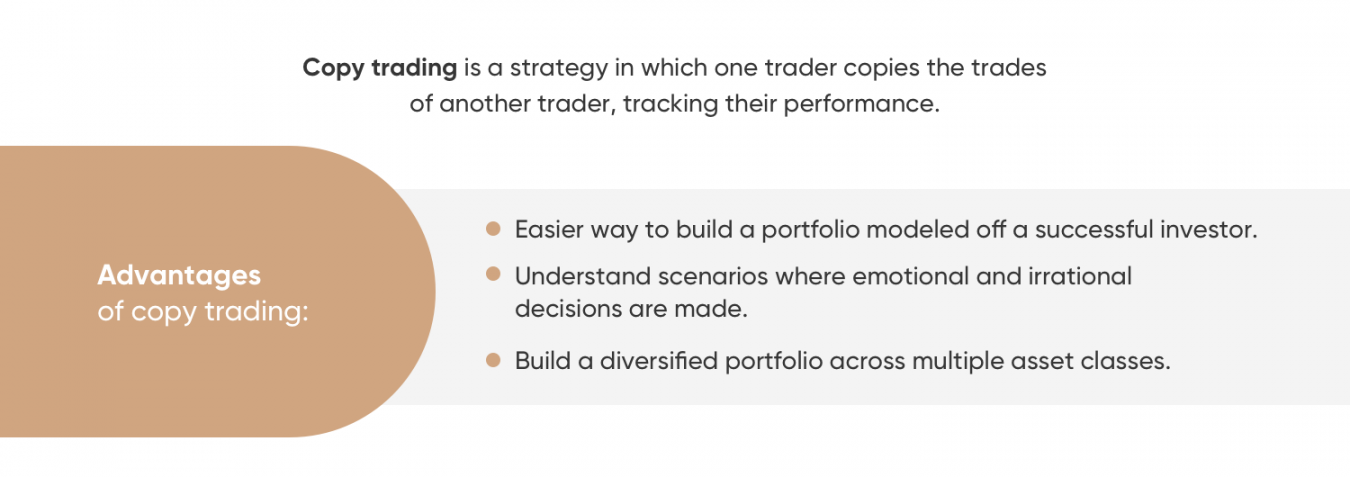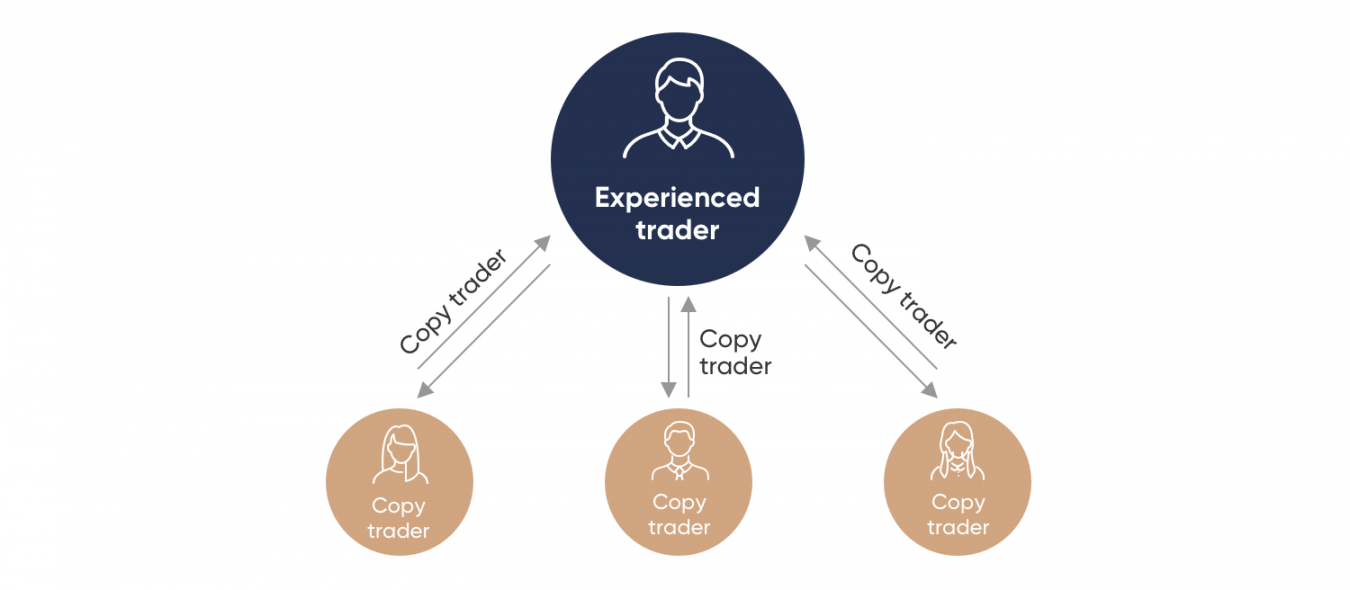Copy trading: how to mimic the best for profits
Wantg to know how to copy the best trader? Read who and how to copy to make a viable trading strategy.
The investment universe can be a confusing space for anyone looking to start trading. Tune in to any of the financial media networks for a few minutes and you’ll see why. From global politics to COVID-19, it seems that anything and everything can affect asset prices.
But it’s never late to take control of your financial well-being and explore different trading strategies. Several years ago investing seemed too complicated for amateurs. But in 2021, financial technology companies have evolved, making trading available for everyone. And there’s a tried-and-tested investment strategy known as copy trading. First, let’s explain what copy trading is and how it works.
What is copy trading?
Offered by several brokers, copy trading, also known as mirror trading or social trading, allows clients to automatically copy the trades of high-profile investors.
Anyone that wants to implement a copy trading strategy will need to identify someone whose investment philosophy aligns with their own. A broker that offers copy trading will have a list of traders and detailed information on their performance.
Some key advantages of copy trading include:
-
Build a portfolio modelled on a successful investor’s trades.
-
Understand scenarios where emotional and irrational decisions are made.
-
Build a diversified portfolio across multiple asset classes.

Copy trading is used even by professional investors. A stock picker who wants exposure to cryptocurrencies but doesn’t have the time to research a new asset class could make use of copy trading.
Similarly, a crypto investor seeking exposure to stocks but who doesn’t know where to start could consider a copy trading strategy
There’s no magical formula on how to copy the best traders. There’s no one-size-fits-all approach to determining what constitutes the ‘best’ trader.
Many are quick to conclude that the ‘best’ trader is the one who generates the highest returns. But, as is often the case, high returns may imply increased risk and a higher potential for large losses. A conservative investor with little room for losses may want to stay clear of traders with unusually large returns.
It’s prudent to carefully research brokers that offer copy trading because specific details vary from company to company.

Copy trading basics
How does copy trading work? Let’s move into greater detail. As a copy trader, you give up some control over your investments. After deciding how much of your portfolio will copy another investor’s, all of their trades are automatically copied by your account.
You don’t need to worry about the size of your account as the system will adjust accordingly. If the trader you’re copying has an account size of, say, $100,000 and makes a purchase for $10,000 (i.e. 10% of their portfolio) then the system will automatically calculate 10% of your portfolio and duplicate that trade – be it a purchase for $50 or $500.
Of course, you decide if or when you want this type of arrangement to end. If you’re unhappy with the choice of the investor you copy from, you’re free to move on to someone else or quit copy trading.
On the other hand, if you’re happy and want to allocate more capital to be copy traded, it can be as straightforward as depositing more cash into your account.
Copy trading shouldn’t be confused with copy trading signals. There’s a big differentiation between the two – an investor who opts for trading signals will merely be notified of a new trading option via a message or e-mail. Some investors prefer this method as it gives them a final veto over how their money is allocated.
In essence, if you’re looking for the easiest explanation on how to copy trade, the answer is simple: the platform does it for you. However, you should do your own due diligence and keep a close eye on those investors you copy (signal providers) and the choices they make, comparing them with your own investment goals.

Stock copy trading
If you want your portfolio to include stocks, but you don’t want to hand-pick them, you can try using a stock copy trading strategy. By becoming a copy trader, you mirror trades of a savvy investor with a demonstrable track record.
You must perform due diligence on an investor you copy or you could find yourself with a portfolio of unknown, highly-volatile stocks.
One tip to maximise a stock copy trading strategy is to look at someone’s portfolio and see if their holdings align with your expectations. New investors should be familiar with ‘blue chip’ stocks, like Disney and Visa. If this is what you are looking for, your research should be relatively straightforward.
If you’re looking for dividend growth, then some additional research might be needed to ensure a portfolio consisting of high-yield paying stocks.
Forex copy trading
Many investors want to hold a basket of global currencies. The forex market is substantially larger than any individual stock market, with daily transactions exceeding several trillions of dollars. The forex market offers 170 currencies available for trading 24 hours a day, except weekends. Retail traders account for around 5.5% of the total international forex trading volume. If you’re one of them, but are new to FX trading, you might consider copying a professional trader.
Forex copy trading often involves trading on margin, which involves serious risk. A loss from one trade can wipe out your entire account balance.
While specific details may vary from broker to broker, some allow customers to take advantage of leverage. This means that you can potentially experience outsized returns while risking less capital. You should be aware that using leverage increases the size of any loss if an asset’s price moves against your position. Be sure to do your own research before investing.
Crypto copy trading
Cryptocurrencies have taken the investment world by storm. Bitcoin’s (BTC) meteoric rise and new cryptocurrencies like dogecoin (DOGE) offer investment potential.
The cryptocurrency universe is large. CoinMarketCap, a price-tracking website for cryptoassets, records more than 11,100 cryptocurrencies, as of 3 August 2021. The total crypto trading volume across the top 10 centralised and decentralised exchanges grew by 69%, up to $7.38gtrn in the second quarter of 2021, according to a report by CoinGecko.
Crypto copy trading is perhaps the riskiest strategy among all asset classes due to the crypto market’s high volatility. However, copying an experienced crypto trader might be a viable trading strategy if you do it in accordance with your own research and only invest money you can afford to lose.
How to choose a trader to copy?
Choosing who to copy is an important challenge in copy trading. Let’s look at some things to consider when picking a trader to mirror:
-
Proven track record.
Check a trader’s performance for at least 12 months. A longer performance history allows you to study the trader’s behaviour and results in various market conditions.
-
Returns
Look for traders who deliver consistent rather than sporadic results. You can do this by looking at a trader’s performance graph. Does it show a gradual increase or irregular spikes?
-
Number of followers
If the trader has a big fan base, it makes them more attractive to copy. People usually follow winners. Although past performance is no guarantee of future success. And a large number of followers means you can use the community to discuss thoughts and strategies. Of course, the final trading decision should always be your own.
-
Risk Level
Choose a signal provider with a similar risk tolerance to yours. Check if they use stop losses and other risk management tools, and consider if their trading behaviour fits with your investment goals.
-
Behaviour after a bad run.
Profitable trades prove a trader’s successful strategy. However, losses are common. It’s important to look at a trader’s behavior in different conditions, including when the market moves against them. For instance, do they stick to a strategy, or do they change course suddenly?

To wrap it up, even if you’ve chosen a trader to copy, learn when to cut your losses. You’re free to drop your signal provider anytime you feel they’re underperforming, or change their trading strategy.